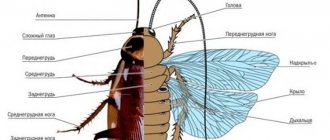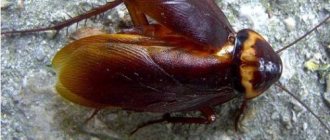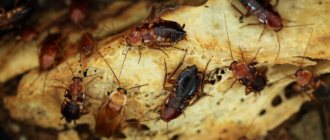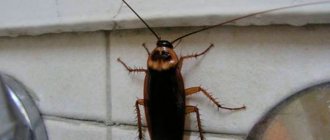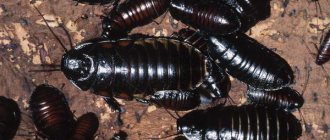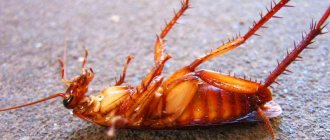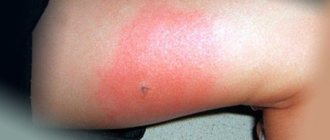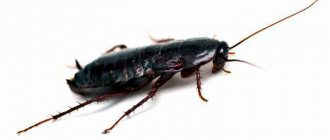White cockroaches - who are they?
Hypotheses refuted by scientists:
- White insects are mutated by high doses of radiation that emit gamma rays. They are indeed capable of acquiring mutations, but this will require a powerful radioactive source, which is impossible to encounter in a human home.
- They are representatives of albinos - the rarest individuals who are congenitally lacking pigmentation. If this were true, then the likelihood of meeting them would be negligible.
- An albino is not a cockroach at all, but a new insect unknown to science . Agree, it is naive to believe that a representative of a new species was able to hide from taxonomists developing new taxonomic units.
- The lack of pigment in the white cockroach is a consequence of its lifestyle in secluded dark places . The theory was criticized due to the fact that no relationship was found between exposure to light and the intensity of the color of the cockroach.
Interesting! Some chlorine-containing insecticides can temporarily inhibit pigment synthesis in animals. This may be the reason for the temporary fading of the color of the poisoned insect. In fact, an albino is a nymph that has just shed its small chitinous scales, and not a new species of cockroach.
White individuals are less common than others for two reasons:
- the chitinous cover is colorless for a short time: after 4-6 hours the pigment gives it a light brown color;
- During molting, insects are vulnerable, so they hide in secluded places where they will not be taken by surprise.
As a result of molting, the larva forms a young, colorless chitinous cover under the old shell. Pigmentation promotes its hardening and begins a few hours after the scales are shed.
The last moult transforms the nymph into an adult, which in the first hours of life is also devoid of color. Soon the pigment accumulates, and the insect takes on its usual appearance.
What do regular cockroaches look like?
Prussians are happy to settle in apartment buildings - nimble brown creatures that are rapidly increasing their population. Their characteristic features are:
- narrow body 13-16 mm long;
- wings incapable of full flight;
- thin antennae that capture odors;
- six legs covered with fine teeth;
- chitinous shell.
A shiny brown color with two black stripes on the back is the calling card of red cockroaches. Therefore, having noticed a milky-white arthropod, a person experiences anxiety and asks a logical question: “Where did this mutant come from?”
Characteristics of the variety
The body of a common cockroach is oval-shaped. Its length can reach 1.5 cm. Each individual has 3 pairs of paws equipped with hooks and suction cups that help the insect easily move along a vertical surface.
Cockroaches come in different colors and sizes
Males have long wings and whiskers, while females have much shorter wings. White individuals have the same characteristics, they are distinguished only by color. Light representatives are not identified as a separate species, so many do not even know whether white cockroaches actually exist. The nature of these insects is designed in such a way that they can be at a certain stage of the life cycle, when their difference in color from their fellow insects is only one of the stages of development through which all individuals pass.
Where does the white cockroach live?
Photo: White cockroach in the apartment
Cockroaches are one of the most common representatives of the animal world. It is extremely difficult to find a place on the planet where they do not exist. Even in particularly extreme conditions, they easily manage to survive, adapting to everything. This is why it is extremely difficult to identify any specific region where cockroaches live. They can live in houses in any city, on any continent.
If we talk about white cockroaches, that is, common ones during the molting period, then most often they try to hide away, choosing secluded dark corners for this. Not only molting occurs there - they try to wait until a sufficiently strong chitinous shell is formed in order to be able to protect themselves.
The bathroom, places behind furniture and under the sink, ventilation shafts, basements - these are the places where arthropods can most often be found. By the way, when they choose ideal habitats for themselves, they try to focus primarily on ensuring that water and food are located as close as possible. Liquid and nutrients are what the insect needs, especially during the formation of the chitinous shell. In the dark, they can get out of hiding and move freely around the kitchen in the direction of the trash can or animal feeder.
Interesting fact: Often the appearance of white cockroaches indicates that the number of individuals has increased.
What does the white cockroach eat?
Photo: Little white cockroach
The white cockroach, since at this moment it begins to molt, needs an increased content of nutrients and liquids. These insects are extremely unpretentious eaters. Basically they can eat anything. Any waste is attractive to them. It can be bread, vegetables, but most of all arthropods prefer sweets. Baked goods and sugar are what will become a real treat for them.
Cockroaches do not disdain absolutely any food that can be found in a person’s kitchen. That is why there is always such an emphasis on the need to clean up after yourself and not leave leftover food on the table. The reason is that this is what especially attracts insects, ultimately provoking their even greater reproduction. At the same time, even in particularly clean families, a similar problem can happen. This is due to the fact that cockroaches can quite freely find food in garbage cans. That is why their main habitat outside homes is landfills.
Since a cockroach, like any other living creature, cannot do without food, if it lives on the street, it is forced to find food near human habitats. That is why cockroaches can still be found much more often in cities. By the way, brown Prussians often become the inhabitants of houses and apartments. Black cockroaches are very rare in homes. Under natural conditions, it can also feed on small insects and the remains of fallen vegetables, fruits, and berries.
Features of character and lifestyle
Photo: White transparent cockroach
Cockroaches most often live in large colonies, trying to find a common habitat. They do not have any clear hierarchy. Although you can often find information that they have dominant individuals, as well as those that obtain food for them. Cockroaches do not have any special skills, nor do they have any skills. That is why these insects are not considered highly organized.
They live mainly in human habitation or near it. Since this is precisely the key to sufficient food for these arthropods. Otherwise, they do not have any special lifestyles. In addition, cockroaches are carriers of such dangerous infectious diseases as dysentery, defthyria, various common poisonings and skin diseases. That is why people have been fighting them so actively for many years.
Cockroaches are rather nocturnal inhabitants. During the day they are much less active. This is primarily due to the fact that they prefer to simply hide from people. That's why it can be difficult to find them during the day.
Unlike many other insects, cockroaches do not hibernate. This is due to the fact that they live near human habitation and therefore are supplied with sufficient quantities of water, drinking and comfortable living conditions all year round. Reproduction in these arthropods therefore also occurs all year round, without any cycle depending on the season.
Social structure and reproduction
Photo: Black and white cockroach
Cockroaches reproduce very actively and in large quantities.
To do this they need:
- food;
- water;
- darkness;
- warm.
At low temperatures, insects die. High ones are tolerated much better. A cockroach can go without food or water for up to 50 days. But if we talk about the breeding period, then at this time much more nutrients are required. Each mature female reproduces up to 5 times during her life. Each one produces up to 50 individuals. When the female reaches maturity, she begins to thin out a kind of scents to attract males. In turn, they find and fertilize the female.
The female reaches sexual maturity at about six months. During the mating process, fertilization of all accumulated eggs occurs. After this, a cocoon begins to actively form, in which the larvae are stored for about 3 weeks. When they get stronger, the female dumps it in a secluded place, where the larvae continue to actively develop and emerge out after a couple of weeks. Newborn cockroaches are white in color. After a few hours they will darken.
Interesting fact: In some exotic species, pregnancy can last up to six months.
Virtually no toxic substances have any effect on egg laying. Therefore, you need to process the house several times to destroy the hatched individuals.
Reproduction of cockroaches
Cockroaches reproduce sexually. Moreover, to successfully breed offspring, a female only needs one mating in her entire life, thanks to the mechanism of preserving the male’s seminal fluid in special sections inside the abdomen. These sperm reserves will fertilize eggs throughout the female's life.
After mating, the female begins to lay eggs, enclosed in a special protective capsule called an ootheca. The ootheca of cockroaches perfectly protects the future offspring of the insect from all types of unfavorable factors, including poison dissolved in water, since it does not allow moisture to enter, and it is not so easy to crush it.
In such a strong capsule, the larvae quietly develop for a couple of weeks, and before the immediate hatching of the offspring, the female will hide it in a safe place. It is very difficult to find cockroach eggs in an apartment, because they are hidden in places that are difficult or completely inaccessible to humans. Consequently, if you destroy adult cockroaches in an apartment, then soon new offspring will hatch in secluded places and another pest takeover of the apartment will begin.
Life cycle of a domestic cockroach
The average lifespan of a domestic cockroach is 10-12 months. During their lives, cockroaches actively feed and reproduce. The female is capable of bearing from 5 to 20 oothecae, in each of which from 15 to 60 larvae can develop.
In total, in one year the female is capable of replenishing the colony by 500 individuals! Cockroaches reproduce constantly, regardless of the time of year and the weather outside, because ideal conditions are created in the apartment next to a person.
Features of cockroach population regulation
Cockroaches have learned to regulate their numbers in a single apartment, which once again confirms the presence of intelligence in these parasites. It would seem, why do they need this when they can reproduce until they lose their pulse? Everything is very simple, cockroaches maintain a certain number of colonies in the apartment for their comfortable existence.
For example, as soon as cockroaches get into a new apartment, where there is a lot of space and food, they begin to multiply intensively and take over the apartment as long as they have enough food and secluded places. The maximum number of individuals is reached and the growth of the colony stops; reproduction is reduced to maintaining the existing number.
Why did there become more cockroaches after treatment?
The destruction of cockroaches usually leads to two consequences: there will be no cockroaches at all or there will be even more of them. In the first case, the disinfestation of cockroaches was successful - the entire colony was infected with poison and destroyed. After persecution, sometimes at first you get the impression that there are more cockroaches on the contrary, but this is not so, it’s just that under the influence of the drugs, all the infected individuals crawled out of secluded places and catch your eye. Soon all the insects will die.
In the second case, the baiting simply failed and not all cockroaches or their larvae were destroyed, then the insects switch on a signal to reproduce. Cockroaches understand that they are trying to be destroyed and therefore begin to reproduce with double effort.
If after the persecution at least 3-5% of the population survived, then in just a month the previous population will completely recover, adding 15-20% in number compared to the previous number.
Why is cockroach control unsuccessful?
Disinfection against cockroaches may fail in the following cases:
- the apartment is in a deplorable state - there is chaos and complete unsanitary conditions - treatment alone is not enough, since there are so many cockroaches that there is not enough poison for all of them, or the individuals hidden deep in the cracks have completely developed immunity;
- saved on processing - “the stingy pays twice” - turned to , which means a cheap drug was used, or very diluted with water, professional ULV equipment was not used (destruction of cockroaches with fog), which means the drug did not get into all the cracks and live cockroaches remained;
- the residents did not at all comply with or neglected the rules specified in the memo (agreement) before and after treatment. For example, there are a lot of things and rubbish in the apartment; the treated surfaces are washed immediately after treatment.
Therefore, in case of unsuccessful baiting of cockroaches, you should not immediately make claims to the SES service; the overwhelming majority of failures are the fault of the apartment owners themselves, who neglect basic hygiene rules and after treatment or skimp on the services of real professionals.
How cockroaches turn white
White cockroaches are not a separate species of cockroach. These are representatives of the same species that already live in the apartment, and are simply at a certain stage of development. Simply put, white cockroaches are freshly molted red, black or American cockroaches.
During the process of molting, the cockroach's previous chitinous covering disappears, in its place a new soft cuticle remains. There is still little pigment in it, which is why it, and the cockroach itself, appears white.
Molting occurs in these arthropods 5-7 times during their life. Its amount depends on the species, living conditions of the parasites, availability of food and several other factors. Red cockroaches, most often living in apartments, molt 5-7 times.
Thus, each cockroach turns white at least 5 times during its 9-10 month life.
A white cockroach next to a discarded skin.
Why do cockroaches need to molt? The fact is that they, like most arthropods, do not have a skeleton, so its functions are performed by the external chitinous cover. Due to the absence of a spine, in order to maintain the integrity and rigidity of the body, the cover must be quite strong. Due to this, it protects the insect from accidental injuries and sometimes attacks from predators.
Cockroaches hatch from eggs into small larvae, and their size increases several dozen times during their life. The chitin shell, due to its rigidity, cannot stretch or grow; accordingly, it does not allow the insect to grow. Because of this, at a certain point, molting occurs. The grown cockroach breaks the chitinous shell, under which by this time there is already a new soft and elastic cuticle. Having gotten rid of the old cover, it, one might say, stretches out and stretches its new chitin to the size it needs, after which it soon hardens and darkens.
In fact, throughout its life, a cockroach grows precisely during molting. When the new shell hardens, resources begin to accumulate in his body for the next change of chitin, but no change in body size occurs.
After all the molts, a sexually mature cockroach emerges from the larval shell. At the moment, it also has a white color, but its shell quickly darkens and hardens. After this molt, they develop wings, if individuals of a particular species have them.
A female black cockroach emerging from the nymphal coverings - her wings are very small, reduced.
Common red cockroaches, also called cockroaches, have wings in both female and male individuals. Consequently, you can also see white cockroaches with wings at home. However, such meetings occur extremely rarely.
Why then are white cockroaches so rarely seen?
Transparent cockroach! Why do you rarely see him and should you start getting to know him with a photo on the Internet? Cockroaches are arthropods, and, accordingly, like all their fellows, they do not have a backbone, which makes them invertebrates.
In fact, cockroaches don't have any other bones. But in order for a cockroach's muscles to properly control its legs, wings, and other moving parts, they must be attached to something rigid. This is why insects have hard external bodies.
This external skeleton, or exoskeleton, provides the structure their bodies need to function properly.
Because the exoskeleton is rigid and cannot change size once it is “installed” on the insect, cockroaches must grow as they mature. Therefore, they participate in a process called “molting.” During molting, cockroaches periodically shed their exoskeleton, replacing it with a more spacious model that allows them the interior space they need to continue to grow.
Before they shed their old outer shell, or skin, they must form a new one just inside the old one to keep the body parts together and to retain body moisture when they shed. This new skin, or exoskeleton, is initially soft and pliable and lacks the pigmentation that gives the shell its color.
When cockroaches are ready to molt, they split the old skin and crawl out. The new exoskeleton is ready to go, but it is still very soft. Since the pigmentation process is not yet complete, the skin becomes white.
Why then are white cockroaches so rarely seen?
By shedding its hard chitinous cover, the insect becomes defenseless against predators and other dangers. During this process, which takes from 10 to 20 minutes, the cockroach cannot even escape from the place. In the next few hours, while the new shell remains soft, it is also at its most vulnerable. Instinctively understanding this, the parasite chooses the calmest and most secluded places for molting, where nothing will threaten it. It remains in such a shelter until the new chitinous cover is completely strengthened. After this, having regained the ability to run quickly, he goes in search of food.
This cockroach moulted a few minutes ago.
Thus, even in a house where there are many cockroaches, it is very rare to see a white one among them. During molting, they hide in places where no one looks unless absolutely necessary, for example, under baseboards, under furniture, and sometimes in household appliances. People, as a rule, see only those individuals that leave their shelters, going in search of food, and, therefore, practically do not see molters.
It is also worth considering that a cockroach mostly sheds while it is still very small. The most intensive growth occurs in the first weeks and months of life, when the insect has to regularly change its shell. During this period, nymphs grow to only 2-5 millimeters. It is difficult to notice such a small insect even on an open surface, especially at night. In addition, nymphs mainly live in hidden places where they are not threatened. There is usually enough food for them there, so they have no need to get out somewhere and run along the walls and tables.
In infected apartments, as a rule, there are from several dozen to several hundred cockroaches, respectively, and white ones appear there every day. In such a population there are always individuals who go through a period of molting. Let's do some rough calculations. One nymph develops within 75-120 days, during which time she changes her chitinous cover seven times, that is, she does this once every 17-18 days. Thus, if 18 or more nymphs live in an apartment, then every day one of them turns white for several hours. It is difficult to find her in this condition. Nobody does this purposefully, and nymphs do not risk getting out into open places during molting, so people see them quite rarely.
Plus also keep in mind that the period when a cockroach is white is very short. It is less likely to accidentally stumble upon it in this state than when it has its usual dark coverings.
We decided to conduct a small experiment and see how cockroaches molt.
Life stages of a white cockroach
The life cycle of white cockroaches begins with a nymph (larva) once these individuals have “successfully” hatched from the egg.
The nymphal stage is the second phase of the cockroach life cycle. This stage of cockroach development is precisely identified by its unusual white color.
All nymphs go through a well-known process of shedding their skin called molting. As all cockroaches develop, they go through periods known as instars. At this time, feeding is accompanied by the loss of old skin. 1 female German cockroach can produce about 400,000 cockroaches per year.
Once cockroaches shed their skin, they turn into milk cockroaches for a couple of hours or days, depending on their species. At this stage they are very vulnerable due to their soft skin.
The color of these cockroaches can be cream, white or light brown, depending on how much time has passed since they moulted. Once their skin hardens, it returns to its typical reddish or dark brown color. The number of molts depends on the type of cockroaches and the conditions in which they are found.
Cockroaches are very sensitive to drying out and predation after molting, so during this period cockroaches remain hidden from light and moving air. The new shell is not rigid enough for the muscles to move quickly at this point, making it difficult to run and hide when being chased by predators. These factors, combined with the possible disruption of their biological clock, is a natural reason for cockroaches to stay out of sight while they are white.
What happens to the white cockroach next? How does he continue to live? The exoskeleton will begin to harden and return to normal coloring over the next few minutes, and life will soon return to normal. Some types of cockroaches can completely transform within a few hours. At this point, the cockroach, now dressed in new armor, is ready to go in search of food, water and shelter. If this is their last molt, then small apartment cockroaches have reached adulthood.
What do sewer cockroaches look like and how to deal with them?
Insects, including cockroaches, tend to be a problem in many older buildings. Although it is unusual, it is not uncommon to see cockroaches coming out of gutters, especially in older buildings. It is known that, at the moment when targeted baiting of insects begins in some place, detecting pesticides, cockroaches try to escape from the poisoning zone in any possible way, including from drains.
Cockroaches can hold their breath for 40 minutes. This allows them to move from house to house through sewer systems. By the way, before you flush cockroaches down the toilet, remember this fact. Flushing a cockroach will not kill it.
These insects quickly develop immunity to many of the insecticides that have been used to kill them for years. Cockroaches are apparently smart enough to detect pesticides and find ways to avoid them. The sewers are a great way to escape and migrate to new safe areas.
From the point of view of cockroaches, the sewer is an ideal home. They thrive in the damp darkness, feeding on decaying organic matter and countless refuse. The underground sewer system is a real resort for them: warm in winter and cool in summer. Sewers provide protection from people and predators (with the possible exception of hungry rats). There is plenty of water here, and their lunch takes place in a 24-hour restaurant with a self-assembled tablecloth of delicious human waste.
Differences from the rest
The insect has all the qualities of a domestic cockroach . They became famous neither for their remarkable survival rate, nor for their gluttony, nor for their danger to people. On the contrary, during the “colorless” period of life, the insect is most vulnerable due to the fragility of the newly formed protective shell.
Albinos, like other individuals, live close to humans, but due to their vulnerability they choose secluded places:
- cracks under the bathroom, furniture;
- defects in the walls, between baseboards;
- basements.
More often than adults, a white nymph is found, mistaken for a new species of insect and frightening with its unusual color and lack of wings.
Interesting! Now it is clear why the color intensity of cockroaches varies so much: the more time has passed since the last change of the old shell, the darker the color of the chitinous cover.
Origin of the species and description
Photo: White cockroach
In nature, it is extremely difficult to find pure white animals. This applies to any species, including cockroaches. These are called the collective concept of “albinos” (a genetic pathology in which there is no production of melanin, the skin pigment).
There are various factors for this phenomenon. But in the case of cockroaches, the reason is often completely different. In any case, you need to understand that when meeting a white cockroach, in fact, a person is always dealing with an ordinary Prussian. The reason for such an unusual color is that the cockroach has a fairly dense shell that is not able to stretch or grow with the animal. That is why he has to shed his chitinous coating. That is, when meeting a white cockroach, you need to understand that simply no more than a few hours have passed since the molting.
Are white cockroaches dangerous for humans?
Firstly, white cockroaches do not pose any danger to people. They are more harmless than dark individuals that could recently move through garbage chutes, collecting various bacteria on themselves, and then walk on the kitchen table, leaving them there. White parasites are usually “clean”. They recently changed their entire coat, including their paws, but they haven’t had time to get the new one dirty yet.
Secondly, a white cockroach is much easier to crush. His body is soft and easily injured. Don't forget about this if he crawls out from somewhere in the bathroom or toilet and catches your eye.
Thirdly, the appearance of white cockroaches in an apartment or private house indicates that they live here permanently. Sometimes adult individuals sneak into an apartment from neighbors, but they are noticed, destroyed, and that’s it, the problem is solved. However, if you regularly see white nymphs, it means that a population of these parasites lives in your home. For molting, they choose reliable shelters and do not go far from them; accordingly, these cannot be individuals who have run in by chance. In addition, the constant appearance of white nymphs may mean that there are much more cockroaches in the house than it seems at first glance. This means that you need to start fighting them as soon as possible.
Our specialists have more than once carried out pest control in apartments and various enterprises and found real hordes of cockroaches there, although the owners said that there were only a few of them. As a rule, people see single parasites, although hundreds of them are hidden under baseboards, behind wallpaper, in various crevices and other secluded places. The appearance of white parasites suggests that this is most likely the situation in the house.
The greatest danger lies in the following. During their life, cockroaches shed their chitinous shells 7 times, and after their death, their bodies also remain in the apartment. They contain substances that are strong allergens for humans. Chitin gradually decomposes, and its small particles combine with dust particles and rise into the air that residents breathe. Thus, the more parasites in the house, the more they shed and, accordingly, the more people constantly inhale small remains of their bodies.
According to statistics, in approximately 7-8% of cases, an allergy to chitin and its constant entry into the body are the main causes of chronic rhinitis, nasal congestion, dermatitis and asthma. In addition, there are many people for whom the exact cause of these diseases has not been established, and it is quite possible that they also suffer from an allergy to chitin.
This is what these shed chitinous coverings of cockroaches look like:
They are sometimes considered dead insects.
Thus, if someone in the family constantly has a runny nose, a stuffy nose, or asthma attacks, it is likely that the cause is those same white cockroaches. If they are in the house, but no one has symptoms of an allergy, you need to take into account that with constant exposure to the allergen on the body, it can develop. Such sensitization does not develop immediately. At first, the body reacts normally to the contact of chitinous remains on the mucous membranes, but over time this provokes an increasing immune reaction, as a result of which allergy symptoms begin to appear. Such processes can occur in both children and adults. Young children and infants are most sensitive to chitin.
You can check whether a person is allergic to cockroaches using special allergy tests, which are carried out in medical clinics. However, it is much wiser not to wait for allergies to manifest itself, but to poison cockroaches in a timely manner, before any of the residents develop health problems because of them.
In general, if white cockroaches appear in the house, then he and their relatives need to get rid of them as soon as possible. First, you should treat the apartment using special aerosols or powders, which are sold at different prices. We tested the effects of some of them, and it turned out that certain remedies are really effective. You can also call professional exterminators who will destroy all parasites much faster using cold and hot fog. After disinfestation, you need to try to find all the holes through which cockroaches could enter the house and seal them. The appearance of white cockroaches in an apartment indicates that there are a lot of them, so you need to start fighting them as soon as possible.
Deadly diseases caused by cockroaches
Diseases caused by domestic pests should not be underestimated. Many of them are serious. These include hepatitis, anthrax, salmonella, tuberculosis, colic and even leprosy. Fortunately, the latter is rare. Quite harmless, but still unpleasant are diseases of the gastrointestinal tract, which can also be transmitted by these creatures.
The transmission of the disease occurs, on the one hand, outside your body; pathogenic microbes can last up to 72 hours, waiting to enter your body. Even if you never have direct contact with a daylight-shy overnight guest, there is a risk of infection. Predatory bugs can also contaminate their food with pathogens as they plunder and raid your kitchen supplies.
Why can white cockroaches be dangerous?
Below are the two main problems they can give you:
- Vector-borne diseases that can be transmitted to people and domestic animals;
- Massive infection at home.
These insects are the leading cause of childhood asthma in cities. Never poison cockroaches in a house where allergy and asthma sufferers live. Removing cockroaches using chemicals inside a building will increase their allergies. Catch cockroaches using special devices or vacuum them.
They shed their shell several times during their developmental stage. The corpses of killed insects, their shed skins and excrement can be your allergens; they will cause more and more attacks of illness in children and sensitive people. Therefore, as soon as they are discovered, immediately begin eliminating them. White cockroaches, as well as their adult relatives - whether living or dead - contain allergens in their feces, skin and saliva.
They are carriers of pathogens that include:
- Streptococcus;
- Staphylococcus;
- Salmonella (food poisoning);
- Clostridium;
- Diarrhea;
- Cholera;
- Respiratory infections;
- Typhoid fever;
- Gastroenteritis;
- Pneumonia;
Interesting
Children in contaminated buildings were found to have the most severe cases of asthma. Almost 50% of asthmatic children are sensitive to cockroach allergens.
Refers to strong allergens
Prussians, along with pet hair and plant pollen, are powerful allergens.
Contact with dust particles that have come into contact with the allergen is enough for the following to develop:
- any type of immediate allergic reaction (contact dermatitis, conjunctivitis, urticaria, allergic rhinitis);
- exacerbation of bronchial asthma and the onset of the disease in children.
Interesting! A man presented to a hospital in Taiwan with a foreign body sensation in the nose, allergic rhinitis, lacrimation and conjunctivitis. A live cockroach was removed from the man’s ear, which, according to the patient, had been in the nasal cavity for 3 days.
Can it bite a person?
There is an opinion that a cockroach is capable of biting a sleeping person. Theoretically, this is possible due to the structure of the insect’s oral apparatus, but such bites rarely occur .
Why is the red cockroach dangerous?
Red cockroaches are very nimble. They run around the floors. They rush along walls at full speed, run across tables and disappear at the edge as if by magic. Cockroaches have incredible mobility that is amazing and annoying. But putting aside the fact that cockroaches cause you discomfort and anxiety, let's see whether these insects are dangerous or not.
Do red cockroaches bite?
Yes. Cockroaches can bite people. Although they do not feed on blood or bite for defense, they can bite people (living or dead) if they are hungry enough. But even when they are hungry, these are not aggressive insects.
If you walk into a room full of cockroaches, those cockroaches will run away from your presence and hide. Cockroach bites most often occur during sleep. And, quite often, the bites will be on the eyelids, because cockroaches prefer eyelashes and dead skin. But in principle, bites can appear on the skin anywhere.
Are red cockroaches poisonous?
No. Cockroaches have no poison. If they bite, the marks will appear as red welts that are slightly larger than mosquito bites and look like swelling. But although wounds caused by cockroaches do not contain venom, they can quickly become infected because cockroaches are dirty creatures that carry a lot of harmful bacteria.
Do red cockroaches spread disease?
Yes. A cockroach runs through the sewer and crawls in garbage containers. They love dirty places and dirty things. If there is rotting food somewhere, redheads will find it and feast on it. They will crawl along toilet rims, inside trash cans and in gaps near ovens, and will then carry harmful bacteria onto cooking surfaces, into cupboards and utensil drawers, and into food storage areas.
This spreads bacteria that can lead to a wide range of stomach diseases. In addition, they can cause an increase in asthmatic symptoms in those who suffer from this physical ailment.
Are there pathogens inside red cockroaches?
Yes. Cockroaches can transmit a host of pathogenic microorganisms. Research has linked cockroaches to the spread of salmonellosis, cholera, dysentery, typhoid fever, gastroenteritis, giardia, E. coli, listeriosis, as well as leprosy and plague.
It is important to note that cockroaches are not considered to carry disease and are not a source of disease. They play a supporting role in the spread of diseases, not a primary one.
How to find out if there are white cockroaches in the apartment and where are their nests?
The survival instinct, exacerbated by the lack of a protective shell, drives pests to the most hidden places:
- Under the bathtub or sink.
- In the cracks of furniture, floors, window frames.
- For the back walls of refrigerators, dishwashers, microwave ovens.
- Inside the housings of televisions, computers, radios.
- Under peeling floor coverings: linoleum, parquet, laminate, carpet.
- Inside bales of clothes and shoes stored for storage.
- For mirrors, kitchen furniture hanging on the walls.
- Under the upholstery and bottom of beds and sofas.
- Inside the ventilation ducts.
- In boxes enclosing water and sewer pipes in the toilet.
- For radiator screens.
- Underneath the wallpaper that has partially peeled off the walls.
- On the internal surfaces of a stretch ceiling.
- In the corners of residential premises cluttered with garbage, rarely washed.
Moreover, to survive, pests urgently need a nearby source of water. And they move much slower than insects with chitinous cover. Therefore, white molting cockroaches rarely settle in rooms. Their favorite areas of permanent habitat are kitchens, dining rooms, and bathrooms (toilet rooms).
Attention! The main signs of the presence of insect nests are: multiple traces of feces in the form of dots and crumbs. Remains of recently shed chitinous shells (resemble a dead cockroach). Brown, black, red pollen from scattered shells. Many colorless, almost transparent testicles (or small nymphs).
If you find signs of white cockroaches, immediately call residential pest control specialists. Today it is rarely possible to cope with huge hordes of pests on your own: insects have adapted to household pesticides sold in stores. Only strong toxins can remove them all without exception, licenses for the use of which are issued only to registered cleaning enterprises or sanitary and epidemiological stations.
Why do cockroaches turn white?
The body cover of larvae that have just hatched into the world is small in thickness. There are practically no pigments in the chitinous shells of small pests. That's why arthropods have this appearance. Within 2-3 days, when the baby’s body begins to produce the corresponding pigment, their color will change to darker.
The female Madagascar cockroach, which is a viviparous species, gives birth to white offspring. This reproduction mechanism allows the mother to protect her babies.
Domestic insects become lighter in color as they shed their chitinous cover. Molting is necessary for pests so that they feel comfortable in the shell. After all, as cockroaches grow older, they increase in size.
How to get rid of white cockroaches
So how do you deal with these terrible pests? To know how to effectively deal with cockroaches, you need to learn all the habits of each of them.
Some cockroaches are active at night when they come out of their hiding place to find some source of food.
Some cockroaches love light, and some only consume vegetation. Want to know effective products to kill them.
Each species of cockroach has its own nesting area. These insects spend about 70% of their time in cracks and dark nooks and crannies. That's why you have to find them first and then caulk all the holes and seal all the cracks. The preferred hiding places of any cockroaches are those that have high relative humidity and are located near sources of food and water.
To control cockroaches in your home, control these conditions.
Most cockroaches that live in homes feed not only on food, but also on a variety of materials, such as leather, glue, paste, dead animals, shoe polish and dirty clothes.
Boric acid
An accessible, inexpensive, effective way to get rid of cockroaches, including white ones, is boric acid. It is almost harmless to humans, but has a detrimental effect on insects. White powder is affordable and sold in pharmacies. Its advantage is that it has a detrimental effect on the Prussian esophagus, nervous system, and paralyzes them. Although parasite populations can adapt to many insecticide ingredients, boric acid is not addictive. Disadvantages include long processing times. It will take one to two weeks for the insects to completely disappear.
Boric acid is used in three types:
- alcohol;
- powdery;
- food bait.
It is recommended to wipe countertops and taps with an alcohol solution. It is less effective than bait powder. There is a connection between insects; they notify each other of possible danger. The smell of alcohol scares them.
Note. Before using boric acid powder, study the places of accumulation and movement patterns of cockroaches. In these places the powder is scattered in a continuous path.
Traps are made in two ways:
- Water solution. First, you need to thoroughly wipe all surfaces so that there is no accumulation of water. Then dilute the bag of powder in water. Pour it into a shallow bowl. They are placed in places where Prussians gather, on paths.
- Making traps. To do this, you need to boil an egg and 1 potato tuber. Mash them to a puree-like state. Add a packet of boric acid, mix thoroughly, roll into small balls. Place bait in places where cockroaches gather.
5 recipes with boric acid for cockroaches
The use of boric acid is a simple, time-tested method of fighting cockroaches, including white cockroaches during the molting period.
Sprays and aerosols
The principle of operation is based on spraying insecticides under the influence of pressure in a can, using a built-in pump.
When working with such products, use the following precautions:
- The room is prepared before treatment. All food items are removed and pets are isolated. If there is an aquarium, temporarily turn off the compressor and cover it with a cloth. At the time of work, windows and doors must be closed.
- Use protective equipment: gloves, a cap on the head, a respirator or gauze bandage, preferably safety glasses. Most aerosols do not cause harm to humans, but in high concentrations they are toxic and cause unwanted side effects.
- Anti-cockroach medications are sprayed only at positive temperatures (more than 10⁰ C).
- They try to process the maximum area of the room, including upper shelves, communication niches, and ventilation ducts. It is better to dismantle the baseboard, this is where white cockroaches hide when they molt.
Advice! It is advisable that the processing be carried out by one person. After spraying the drugs, leave the room and leave it closed for several hours. Before sanitizing, you need to read the instructions for the specific drug in detail.
"Dichlorvos", "Dichlorvos Neo"
Proven product from Russian manufacturers. The advantage of Dichlorvos Neo is that it has no characteristic odor.
Effect on cockroaches: nerve agent.
Main active ingredient (EAI): "Dichlorvos" - organophosphorus ingredients (phosphorus + carbon), "Dichlorvos Neo" - peritroids.
Validity: up to two weeks.
Spray "Combat"
Russian spray, manufactured under German license. An additional property is an antiseptic. Advantage: large processing area (more than 60 sq. m).
Impact: contact, affects the food tract of insects.
EDV: imiprotrin, ciferothrin.
"Baron"
Russian remedy for deep impact. Overcomes the protective barrier of the chitinous shell of the cockroach. The disadvantage is the high price.
Impact: nerve paralytic.
EFA: finpronil (3%).
"Raid"
Manufacturer: Russia. The advantage is a prolonged action (up to three months).
EDV: a combination of poisons of the peritroid group.
The effect on cockroaches is combined: nerve-paralytic, contact. It affects white individuals during the period of change of the chitinous shell.
"Raptor"
Manufacturer: China. Transmitted by contact.
EDV: combination of poisons (tetramethrin, peronyl butoxide, cypermethrin).
Impact: affects the nervous, digestive and respiratory systems of insects.
What to do if cockroaches run away from neighbors?
Cockroaches do not always appear in an apartment due to unsanitary conditions. There are several other ways they can appear in your home.
If cockroaches come from neighbors, it is recommended to keep the apartment perfectly clean, throw out garbage every day, put away food, wipe up even small puddles, wipe the bathtub and sink at night, prevent leaks in plumbing and water pipes, put nets on ventilation, seal all cracks and holes .
If there are too many cockroaches in the house, the following methods of dealing with them will help you: all kinds of ready-made powders and crayons (for example, Mashenka), as well as gels, traps, aerosols, repellers, folk methods may help. If the pests cannot be controlled, more drastic measures will have to be taken.
If cockroaches are crawling from your neighbors, it is recommended to agree with them and at the same time invite a special service that will take the necessary measures. If neighbors refuse to poison, they can be forced to do so in court; for this, you will need a document confirming the unsanitary conditions in a particular apartment. You can obtain such a document from the management company, as well as from the sanitary and housing inspection.
How to avoid the recurrence of cockroaches?
To avoid the next appearance of pests in the apartment, after their destruction, you should follow the following recommendations:
- carefully remove food debris from the table and floor;
- Empty the trash can regularly;
- hide food from the table;
- prevent an increase in the level of humidity in the apartment by promptly repairing plumbing, turning off taps and eliminating leaks in pipes;
- try to seal the cracks in the house, which can become a suitable opening for insects from neighboring apartments.
Red cockroaches in the apartment
There are about 20 species of cockroaches known in Europe. About 80% of the damage comes from saffron milk caps. The insect is also known as the German cockroach or Prussian cockroach. The pest causes damage, especially to food. In addition, the common cockroach can transmit diseases. Don't underestimate the health consequences of having whiskered critters and their excrement in your home. Therefore, effective and sustainable control of red cockroaches in the apartment is important. In addition, there are frequent cases of its active presence in restaurants, catering establishments, large kitchens, hospitals and laundries. The economic damage caused by insects is significant.
How to get white cockroaches out of household electrical appliances?
As noted earlier, during the molting period, pests like to hide in household appliances. Quite often, such insects choose televisions, microwave ovens, and toasters as habitats. Here cockroaches can calmly survive the unfavorable period until a new, more durable shell is formed.
To remove insects from electrical appliances, it is enough to expose them to severe frost. Alternatively, the microwave oven can be set to high heat. In this case, the cockroaches will not be destroyed, but they will certainly run away.
If we talk about removing pests from TVs, computers and laptops, where they feel extremely comfortable, in this case you should resort to disassembling the devices and thoroughly cleaning them. The use of chemical insecticides and folk remedies in such situations is not recommended.
Why do cockroaches appear with a permanent white color?
Sometimes albino cockroaches may appear in an apartment or house and remain that way throughout their entire life cycle.
There can be many reasons for this: Gene mutations that occur in individuals, which arise as a result of an unfavorable external environment, exposure to chemicals and constant radiation
Adaptation to natural conditions can also affect color changes. Cockroaches that live in dark places that are not exposed to sunlight can remain white throughout their lives. Typically, these insects do not settle in human homes, but prefer caves, foliage, and basements. Their melanocytes simply do not produce dark pigment, because in such conditions they have no use for it.
The presence of an albinism gene in an individual. Of course, this is a very rare phenomenon in nature. However, it can appear in any insect or animal.
Since cockroaches love baths, toilets, communication networks and other rooms with high humidity, they can become infected with chlorine, which is used to treat surfaces in these rooms. Chlorine poisoning causes cockroaches to change from dark to light in color, as well as lethargic behavior and weakness.
However, at home you can meet an albino insect only during the molting period.
Misconceptions about white cockroaches
Are there white albino cockroaches? Should we be more afraid of such insects than ordinary ones? We will try to answer these and other questions:
- The white cockroach does not retain its translucent body structure and pale hue throughout its life. The acquisition of a familiar appearance occurs quite quickly.
- White individuals are no more dangerous than ordinary cockroaches. Moreover, such insects prefer to hide in secluded places during the daytime, since their delicate bodily shell makes them extremely vulnerable to external influences.
- There is a widespread opinion that white cockroaches are sources of radioactive radiation, as they arose as a result of its exposure. This myth also has no basis, since mutant insects do not exist, which has been confirmed by scientists.
Sources
- https://rusfermer.net/dom-kvartira/vrediteli-vd/tarakany/albinosy.html
- https://vrediteli24.ru/tarakany/belogo-cveta.html
- https://wildfauna.ru/belyj-tarakan
- https://dezincity.ru/tarakani/about/belye-tarakany
- https://KlopVred.ru/tarakany/belye-tarakany-v-dome/
- https://vreditelstop.ru/vrediteli/tarakany/chto-za-belye-tarakany-v-kvartire.html
- https://GdeKlop.ru/tarakany/belye/
- https://FB.ru/article/252582/belyie-tarakanyi-opisanie-prichinyi-poyavleniya-i-sposobyi-borbyi
[collapse]
Methods of disposal
Without its hard shell, a domestic parasite becomes defenseless. It's easier to destroy. Contact toxic substances will work better, penetrate the insect’s body faster and cause paralysis.
It also becomes profitable to use poisonous agents. During molting, insects become incredibly voracious. Along with food, poison will enter their body, which will kill them.
Boric acid
A proven remedy is boric acid. Household pests cannot get used to it and adapt their digestive system. The powder acts through the insides, abrading organs, causing paralysis.
Boric acid also penetrates the chitinous shell, which does not serve as an obstacle in white individuals. Small acid particles have sharp edges; they cause wounds to parasites that do not heal. They damage the organs of vision and breathing.
Cockroach sprays
Good means are modern aerosols and sprayers. Through the air, toxic substances make their way to the most remote places where domestic parasites without a hard shell hide.
Dichlorvos Varan is very popular. All that remains from the old product is its name and increased effectiveness. The former pungent smell of kerosene is no longer there. Significant changes have occurred in the composition of the drug, but it also successfully destroys insect pests.
There is no need to create conditions in the apartment that are comfortable for cockroaches, otherwise they will not settle in this room. Insects love heaps of things; they live comfortably in such heaps. When disassembling, you can immediately see how the parasites scatter in different directions.
The white individuals are a little disoriented and move slowly. They are easy to destroy and are not as nimble as their brown or red counterparts.
Gels for cockroaches
Insecticidal gels, such as Dohlox, help. It is enough to spread this product in places where cockroaches accumulate, and the process of their destruction begins.
Insects eat a product that smells attractive to them. They do not die immediately; they manage to run to the nest. Thereby facilitating the spread of the poisonous composition.
Relatives will eat a dead cockroach, because if they smell the fragrant bait, they will also be poisoned. In this way, the colony of parasites will gradually be destroyed along the chain. Only the gel does not work on eggs; you will have to wait until new individuals hatch and also taste the poisonous delicacy.
